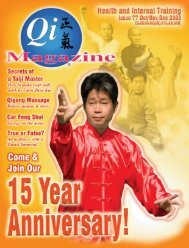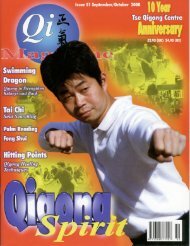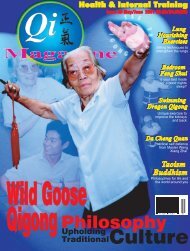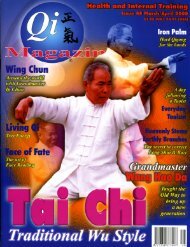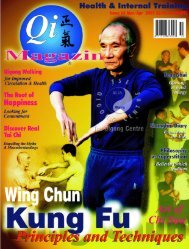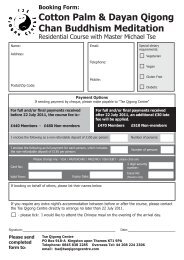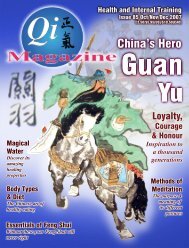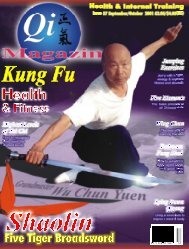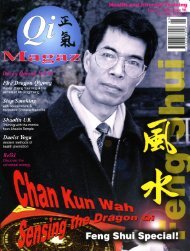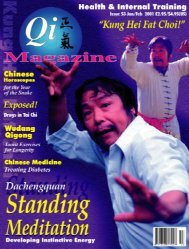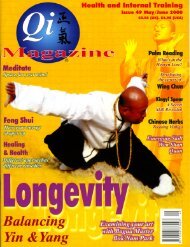Issue 78 - Tse Qigong Centre
Issue 78 - Tse Qigong Centre
Issue 78 - Tse Qigong Centre
- TAGS
- issue
- qigong
- qimagazine.com
You also want an ePaper? Increase the reach of your titles
YUMPU automatically turns print PDFs into web optimized ePapers that Google loves.
In so doing, Master Wu explained, this second time he<br />
saw the same movements and information in a completely<br />
new light, and his practice entered a higher level. He felt not<br />
only that his Tong Bei was new, but that he as a person had<br />
changed too. His teacher told him that whatever one<br />
u n d e r t a k e s ,<br />
whether it be in<br />
martial arts, work<br />
or life in general,<br />
one must do<br />
everything to<br />
one’s best ability,<br />
so that others feel<br />
at ease around<br />
you and will trust<br />
everything you<br />
do.<br />
Master Wu<br />
says that he still<br />
follows his<br />
teacher’s advice and imitates many of his habits, like keeping<br />
a diary about his practice and progress or even any regression,<br />
so as to continuously try to improve himself.<br />
Master Wu went on to explain some of the facets of<br />
Tong Bei in more detail. Every system has its own method of<br />
training, and Tong Bei has three steps: -<br />
1. BASIC TRAINING - DAN CHAO<br />
There are 24 Dan Chao or “single strikes”, which are to<br />
train Fa Jing (the issuing of power) and Nei Jing (internal energy<br />
training).<br />
2. MOVING STEP TRAINING - XING BU<br />
Xing Bu Training also has 24 movements, and within<br />
this stage there are also 3 types of training method.<br />
3. THE TONG BEI FORM<br />
All facets of the Tong Bei system are incorporated in a<br />
linked series of movements which now comprise a full form.<br />
Master Wu explained each aspect more fully. The Dan<br />
Chao includes all kinds of single movement strikes, including<br />
palm strikes, punches, elbows etc, and each strike must be<br />
practised for blows coming in from or going out to any direction,<br />
eg: left/right/up/down/centre, and for delivering the strikes<br />
for both upper, middle and lower positions.<br />
In Tong Bei the hand is never just brought back after<br />
one strike and then thrown back out again; actually the hand<br />
in Tong Bei can strike from wherever it is positioned, so there is<br />
no waste of energy by striking and withdrawing and then striking<br />
again. In Dan Chao one cannot use strength, or “Li”, one’s<br />
arm and body must be relaxed, so that one can use the<br />
intention and Dantian power. The aim of the Dan Chao single<br />
strike training is to be able to get the Dantian power to extend<br />
out from the Dantian and be expressed in the hands and feet.<br />
Dan Chao issuing power (Fa Jing) has five specialities,<br />
which are: Song (relaxed), Kuai (fast), Cui (crisp and clean),<br />
Tan Xing (springy) and Yin (hard). He explained that the strike<br />
in Tong Bei must have all these qualities, and he stressed that<br />
the quality of “hard” does not mean that the practitioner is<br />
rigid or uses strength, rather it relates to the force of the blow<br />
that the opponent will receive.<br />
Every bone has marrow inside, and during the single<br />
movement strikes, one trains the Fa Jing (issuing power) so<br />
that the marrow flows freely through the centre of the<br />
bones.This also has the result of making the arms more powerful<br />
and more resilient than ordinary people’s. Therefore Tong Bei<br />
fighters receive<br />
fewer injuries<br />
“This step is to<br />
harmonize the flow of<br />
Qi and the breathing<br />
with the postures.”<br />
during a fight as<br />
their arms etc are<br />
firmer. Additionally<br />
it teaches the<br />
student to have<br />
“tou jing” or<br />
penetrating power.<br />
The practitioner will<br />
practise the Dan<br />
Chao for up to one<br />
hour everyday.<br />
The second<br />
level of training,<br />
“Xing Bu" or moving step training also has three types of training<br />
method:<br />
The first is slow separate movements, which are<br />
performed in a sequence, but the emphasis is on doing each<br />
one separately to get the correct posture and energy flow.<br />
The second step is to join these 2 or 3 separate movements<br />
together to make just one continuous movement.<br />
The last step in this phase is to put all the practiced<br />
series of movements together into a running form, so that it<br />
comprises one long series of continuous attacks and strikes.<br />
Now one can perform the full form. In the Tong Bei<br />
form itself there are also 3 steps to the training.<br />
1. Gong Li Tai Zhu Quan: -<br />
The form is practised like a series of standing postures.<br />
Each posture within the form is held for the count of at least<br />
three breaths, in order to get the Qi to flow and to be able to<br />
relax into the postures. This way the form can last for over<br />
fifteen minutes.<br />
The main aim of this step is to harmonize the flow of<br />
Qi and the breathing with the postures, to increase the stamina<br />
and to build the root and legs so that the hips and legs have<br />
a good root and can utilize the earth power.<br />
2. Wen Tai Zhu: -<br />
This next step is to practise the intention (or Yi) and the<br />
energy. To make sure that in every movement one has a<br />
sensation that the potential force and spirit, energy and the<br />
intention are all working in harmony and the correct sequence<br />
of the spirit striking the opponent, followed by the energy and<br />
the intention is achieved. And that all postures are practised<br />
correctly.<br />
3. Wu Tai Zhu: -<br />
This last level is to practise the martial applications of<br />
each posture, to check whether the practitioner can use them<br />
or not.<br />
Master Wu stressed that the main aim in all the stages<br />
of the training is to make staying relaxed throughout the natural<br />
state of the practitioner.<br />
The other features of Tong Bei training he said are body<br />
conditioning and two-person training drills.<br />
Qi Magazine Jan/Feb/Mar 2006 page 25



